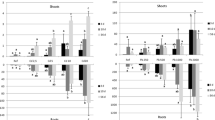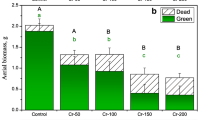Abstract
Three potentially toxic elements [chromium (Cr), lead (Pb), and cadmium (Cd)] were tested to assess their effects on two soils of different properties and origin. The soils were a granitic soil (Haplic Arenosol), which meets the requirements of OECD ecotoxicity testing, and a calcareous soil (Calcaric Regosol) with properties often found in the Mediterranean areas. The metal concentrations used ranged from 0.001 to 5,000 mg kg−1 soil. The effects on soil microbial activity and community composition (respirometry and polymerase chain reaction–denaturing gradient gel electrophoresis analysis), as well as the effects on plant germination and elongation (Lactuca sativa), were assessed. The toxicity of the soil water extracts was also evaluated by the growth inhibition of algal populations (Pseudokirschneriella subcapitata). Cr showed the highest level of toxicity to soil organisms in the assays performed because this element remains in soil as anionic form and is less retained by the soil solid matrix than Cd and Pb. The lowest observed–adverse effect level for Cr ranged from approximately 0.1 mg kg−1 [substrate induced respiration (SIR) test for the granitic soil] to 10 mg kg−1 (basal respiration and SIR tests for the calcareous soil). For Pb (SIR) and Cd (SIR and alga tests), these levels were approximately 100 mg kg−1. Germination and algal tests showed higher sensitivity in Regosol soil than in Arenosol soil for Cr due to differences in the bioavailability between the soils. In the cases or areas where alkaline soils are abundant, these should also be considered in laboratory ecotoxicity testing to avoid underestimation of ecotoxicological risks.


Similar content being viewed by others
References
An Y-J (2004) Soil ecotoxicity assessment using cadmium sensitive plants. Environ Pollut 127:21–26
Banks MK, Schwab AP, Henderson C (2006) Leaching and reduction of chromium in soil as affected by soil organic content and plants. Chemosphere 62:255–264
Bataillard P, Cambier P, Picot C (2003) Short-term transformations of lead and cadmium compounds in soil after contamination. Eur J Soil Sci 54:365–376
Becker J, Parkin T, Nakatsu C, Wilbur J, Konopka A (2006) Bacterial activity, community structure, and centimeter-scale spatial heterogeneity in contaminated soil. Microb Ecol 51:220–231
Bello D, Trasar-Cepeda C, Leiros MC, Gil-Sotres F (2008) Evaluation of various tests for the diagnosis of soil contamination by 2,4,5-trichlorophenol (2,4,5-TCP). Environ Pollut 156:611–617
Blagodatsky SA, Heinemeyer O, Richter J (2000) Estimating the active and total soil microbial biomass by kinetic respiration analysis. Biol Fertil Soils 32:73–81
Bolan NS, Adriano DC, Natesan R, Koo BJ (2003) Effects of organic amendments on the reduction and phytoavailability of chromate in mineral soil. J Environ Qual 32(1):120–128
Bur T, Probst A, Bianco A, Gandois L, Crouau Y (2010) Determining cadmium critical concentrations in natural soils by assessing Collembola mortality, reproduction and growth. Ecotoxicol Environ Saf 74:415–422
Bur T, Crouau Y, Bianco A, Gandois L, Probst A (2012) Toxicity of Pb and Pb/Cd combination on the springtail Folsomia candida in natural soils: reprodution, growth and bioaccumulation as indicators. Sci Total Environ 414:187–197
Cheung KH, Gu JD (2007) Mechanism of hexavalent chromium detoxification by microorganisms and bioremediation application potential: a review. Int Biodeter Biodegr 59:8–15
Dai J, Bécquer T, Rouiller JH, Reversat G, Reversat FB, Lavelle P (2004) Influence of heavy metals on C and N mineralisation and microbial biomass in Zn-, Pb-, and Cd-contaminated soils. App Soil Ecol 25:99–109
Das P, Samantaray S, Rout GR (1997) Studies on cadmium toxicity in plants: a review. Environ Pollut 98:29–36
DIN (1984) German standard determination of the leachability by water (S4). Deutsche Norm, Teil 4 Okt:464–475
Domene X, Alcañiz JM, Andrés P (2007) Ecotoxicological assessment of organic wastes using the soil collembolan Folsomia candida. Appl Soil Ecol 35:461–472
FAO-UNESCO (1998) World reference base for soil resources. FAO, Rome.
Fulladosa E, Murat JC, Martínez M, Villaescusa I (2005) Patterns of metals and arsenic poisoning in Vibrio fischeri bacteria. Chemosphere 60:43–48
García-Lestón J, Méndez J, Pásaro E, Laffon B (2010) Genotoxic effects of lead: an updated review. Environ Int 36:623–636
Gibiat F, Ranjard L (2009) Contamination of soil by copper affects the dynamics, diversity, and activity of soil bacterial communities involved in wheat decomposition and carbon storage. Appl Environ Microbiol 75:7565–7569
Giller KE, Witter E, McGrath SP (1998) Toxicity of heavy metals to micro-organisms and microbial processes in agricultural soils: a review. Soil Biol Biochem 30:1389–1414
Giller KE, Witter E, McGrath SP (2009) Heavy metals and soil microbes. Soil Biol Biochem 41:2031–2037
International Organization for Standarization (2002) ISO 17155 Soil quality. Determination of abundance and activity of soil microflora using respiration curves, ISO
Kirkham MB (2006) Cadmium in plants on polluted soils: effects of soil factors, hyperaccumulation, and amendments. Geoderma 137:19–32
Ko KS, Lee PK, Kong IC (2011) Evaluation of the toxic effects of arsenite, chromate, cadmium, and copper using a battery of four bioassays. Appl Microbiol Biotechnol 95(5):1313–1350
Koukal B, Gueguen C, Pardos M, Dominik J (2003) Influence of humic substances on the toxic effects of cadmium and zinc to the green alga Pseudokirchneriella subcapitata. Chemosphere 53:953–961
Kozuh N, Stuparm J, Goreng B (2000) Reduction and oxidation processes of chromium in soils. Environ Sci Technol 34:112–119
Kuzyakov Y, Blagodatskaya E, Blagodatsky S (2009) Comments on the paper by Kemmitt et al. (2008) Mineralization on native soil organic matter is not regulated by the size, activity or composition of the soil microbial biomass—a new perspective. Soil Biol Biochem 40:61–73: the biology of the regulatory gate. Soil Biol Biochem 41:435–439
Laxman RS, More S (2002) Reduction of hexavalent chromium by Streptomyces griseus. Miner Eng 15:831–837
Li B, Zhang H, Ma Y, McLaughlin MJ (2011) Influences of soil properties and leaching on nickel toxicity to barley root elongation. Ecotoxicol Environ Saf 74:459–466
Lin Q, Brookes PC (1999) An evaluation of the substrate-induced respiration method. Soil Biol Biochem 31:1969–1983
López-Luna J, González-Chávez MC, Esparza-García FJ, Rodríguez-Vázquez R (2009) Toxicity assessment of soil amended with tannery sludge, trivalent chromium and hexavalent chromium, using wheat, oat and sorghum plants. J Hazard Mater 163:829–834
Manzo S, Picione FDL, Rocco A, Carotenuto R, Maisto G (2010) Urban and agricultural soil ecotoxicity and heavy metal contamination. Fres Environ Bull 19(8B):1749–1755
Martí E, Sierra J, Sánchez M, Cruañas R, Garau MA (2007) Ecotoxicological tests assessment of soils polluted by chromium (VI) or pentachlorophenol. Sci Total Environ 378:53–57
Martí E, Sierra J, Cáliz J, Montserrat G, Vila X, Garau MA et al (2011) Ecotoxicity of chlorophenolic compounds depending on soil characteristics. Sci Total Environ 409:2707–2716
Mench M, Bes C (2009) Assessment of ecotoxicity of soils from a wood treatment site. Pedosphere 19:143–155
Ministerio de la Presidencia (Gobierno de España) (2005) Real Decreto 9/2005 Boletín Oficial del Estado 8 Enero. Madrid, pp 1833–1843
Moscoso F, Bouzas S, Gil-Sotres F, Leirós MC, Trasar-Cepeda C (2007) Suitability of the OECD tests to estimate contamination with 2,4-dichlorophenol of soils from Galicia (NW Spain). Sci Total Environ 378:58–62
Muyzer G, Smalla K (1998) Application of denaturing gradient gel electrophoresis (DGGE) and temperature gradient gel electrophoresis (TGGE) in microbial ecology. Antonie Van Leeuwenhoek 73:127–141
Natal da Luz T, Ojeda G, Costa M, Pratas J, Lanno RP, Van Gestel CAM et al (2012) Short-term changes of metal availability in soil. Part I: comparing sludge-amended with metal-spiked soils. Arch Environ Contam Toxicol,
Nordgren A, Bååth E, Söderström B (1988) Evaluation of soil respiration characteristics to assess heavy metal effects on soil microorganisms using glutamic acid as a substrate. Soil Biol Biochem 20:949–954
Organisation for Economic Co-operation and Development (2000) Guidelines for the testing of chemicals. Soil microorganisms: carbon transformation test 217
Organisation for Economic Co-operation and Development (2002) Guidelines for the testing of chemicals. Proposal for updating guideline 201. Freshwater alga and cianobacteria. Growth inhibition test. Draft revised document
Organisation for Economic Co-operation and Development (2003) Guidelines for the testing of chemicals. Proposal for updating guideline 208. Terrestrial plant test: 208. Seedling emergence and seedling growth test. Draft document
Roane TM, Pepper IL (1999) Microbial responses to environmentally toxic cadmium. Microb Ecol 38:358–364
Roca-Perez L, Gil C, Cervera ML, Gonzálvez A, Ramos-Miras J, Pons V et al (2010) Selenium and heavy metals content in some Mediterranean soils. J Geochem Explor 107:110–116
Rocha L, Rodrigues SM, Lopes I, Soares AMVM, Duarte AC, Pereira E (2011) Water soluble fraction of potentially toxic elements in contaminated soils: relationships between ecotoxicity, solubility and geochemical reactivity. Chemosphere 84:1495–1505
Sandaa RA, Torsvik V, Enger Ø (2001) Influence of long-term heavy-metal contamination on microbial communities in soil. Soil Biol Biochem 33:287–295
Shanker AK, Cervantes C, Loza-Tavera H, Avudainayagam S (2005) Chromium toxicity in plants. Environ Int 31:739–753
Shi W, Bischoff M, Turco R, Konopka A (2002) Long-term effects of chromium and lead upon the activity of soil microbial communities. Appl Soil Ecol 21:169–177
Speir TW, Kettles HA, Percival HJ, Parshotam A (1999) Is soil acidification the cause of biochemical responses when soils are amended with heavy metal salts? Soil Biol Biochem 31:1953–1961
Stephenson GL, Koper N, Atkinson GF, Salomon KR, Scroggins RP (2000) Use of non-linear regression techniques for describing concentration-response relationships of plant species exposed to contaminated site soils. Environ Toxicol Chem 19:2968–2981
Swartjes FA, Carlon C, de Wit NH (2008) The possibilities for the EU-wide use of similar ecological risk-based soil contamination assessment tools. Sci Total Environ 406:523–529
United States Environmental Protection Agency (1998) Method 3051 A. Microwave assisted acid digestion of sediments, sludges, soils and oils. Test methods for evaluating solid waste, USEPA
VanGestel CAM, Borgman E, Verweij RA, Díez M (2011) The influence of soil properties on the toxicity of molybdenum to three species of soil invertebrates. Ecotoxicol Environ Saf 74:1–9
Vig K, Megharaj M, Sethunathan N, Naidu R (2003) Bioavailability and toxicity of cadmium to microorganisms and their activities in soil: a review. Adv Environ Res 8:121–135
Voigt A, Hendershot WH, Sunahara GI (2006) Rhizotoxicity of cadmium and copper in soil extracts. Environ Toxicol Chem 25:692–701
Acknowledgments
The study was financed by the Spanish Ministerio de Ciencia y Tecnologia (REN2003-09513 C0201).
Author information
Authors and Affiliations
Corresponding author
Rights and permissions
About this article
Cite this article
Martí, E., Sierra, J., Cáliz, J. et al. Ecotoxicity of Cr, Cd, and Pb on Two Mediterranean Soils. Arch Environ Contam Toxicol 64, 377–387 (2013). https://doi.org/10.1007/s00244-012-9841-9
Received:
Accepted:
Published:
Issue Date:
DOI: https://doi.org/10.1007/s00244-012-9841-9




